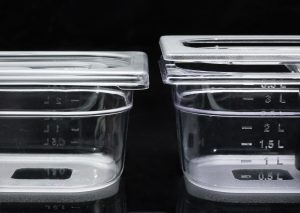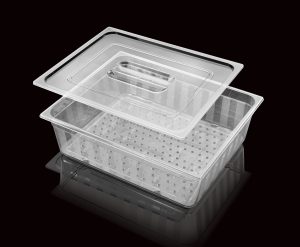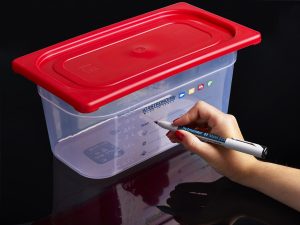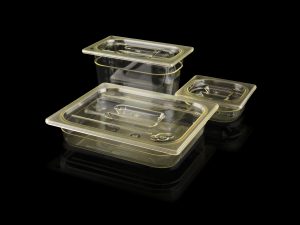NEUHEITEN
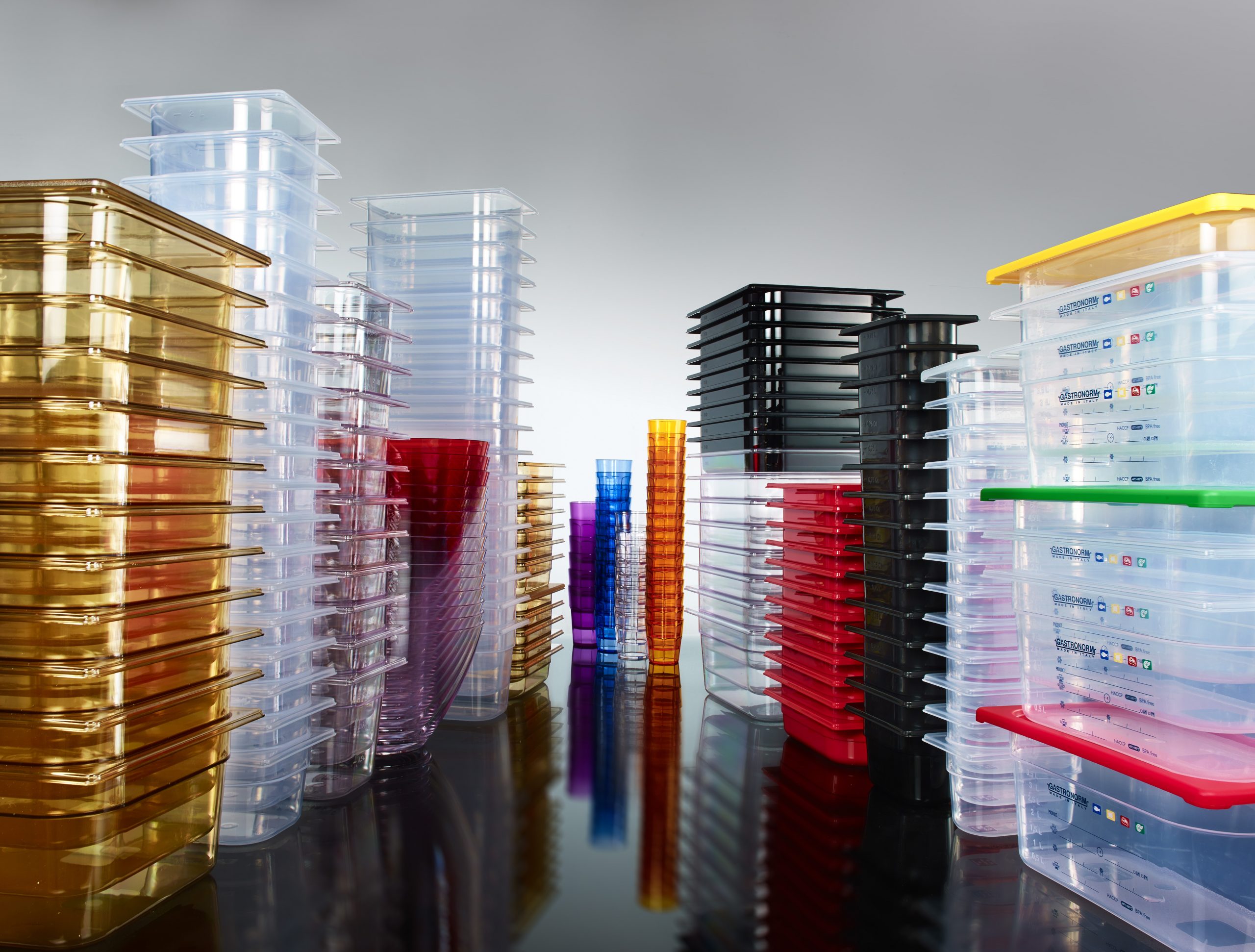
PLASTIC MATERIALS: PROPERTIES AND APPLICATIONS
In this excerpt, we want to provide some essential knowledge on the main types of plastic materials that are used for food contact and outline their main differences. Specifically, we will discuss the following materials: polycarbonate, Tritan, polypropylene and Grilamid.
POLICARBONATO
Polycarbonate, (PC), is a high-performance, sustainable and eco-efficient material used in a wide variety of everyday applications. It has a unique combination of properties: it offers transparency, durability, safety, versatility, as well as heat and impact resistance.
Properties
Polycarbonate enables the manufacture of high-performance technical products in sophisticated shapes and sizes.
Its main advantages are:
- High durability: polycarbonate is an extremely strong material. This makes it the ideal material where product life and performance reliability are paramount.
- Impact resistance: It is virtually indestructible. Through its high impact resistance, it provides increased safety and comfort for applications where reliability and high performance are essential.
- Transparency: it is an extremely clear plastic (0.6 HAZE) offering excellent visibility.
- Lightness: the low density of polycarbonate allows architectural and design creativity to be unleashed. This leads to greater resource efficiency and reduced financial and environmental costs for transport.
- Thermo-stability: polycarbonate provides excellent heat resistance, facilitating hygienic conditions during cleaning at higher temperatures.
- Innovative potential: the performance of polycarbonate is continuously improved. Through technical and scientific innovation, new applications and product benefits are offered to develop market sectors, providing consumers with additional services and benefits.
TRITAN
Tritan™ is a co-polyester from EASTMAN CHEMICAL that is Bisphenol A-free (BPA-free). It is undoubtedly the best alternative to polycarbonate to date
Features
- Excellent transparency (comparable to polycarbonate)
- Very good impact resistance
- Very good resistance to washing cycles
- Improved oxygen barrier compared to polycarbonate
- Excellent chemical resistance
- Resistant to temperatures of -40°C +90/100°C
- Pleasant to the touch and less dry sounding
FOCUS BISPHENOL A (BPA)
Bisphenol A, usually abbreviated to BPA, is an organic component with two phenol groups; it is a key building block in the synthesis of plastics and plastic additives. It is certainly one of the main monomers in the production of polycarbonate. Evidence about the toxicity of Bisphenol A has accumulated over the years, starting in the 1930s and increasingly in the last decade. The fear is that BPA can interfere with hormone balance and damage brain development, reproductive organs in both foetuses and adults, and the immune system if certain migration limits are exceeded.
Since 2010, some governments, such as those of Canada and France, have decided to ban the use of BPA in the manufacture of plastic food and drink containers for children up to the age of three. Following these actions, the European Commission adopted Directive 2011/8/EU which established a ban on the production of polycarbonate baby bottles containing Bisphenol A from 01/03/2011 and a ban on their import and marketing from 1 June of the same year.
EFSA published the results of its comprehensive review of BPA toxicity and exposure in January 2015, and reduced the Tolerable Daily Intake (TDI) from 50 to 4 µg/kg body weight. The Tolerable Daily Intake is an estimate of the amount of a substance, expressed on a body weight basis, that can be ingested daily over a lifetime without appreciable risk.
Recently, after completing the development of a protocol for assessing BPA-related hazards in November 2017 and piloting the methodology for evaluating the studies (2019), EFSA’s CEP Panel is working on the re-evaluation of the public health risks of BPA in food.
The Tolerable Daily Intake (TDI) of Bisphenol A (BPA) has been proposed to be significantly lowered from that established in 2015, setting it at 0.04 nanograms per kilogram of body weight per day, following the evaluation of the results of studies published from 2013 to 2018.
Given the levels of human exposure to BPA, EFSA estimates that the levels of exposure found in the population far exceed the new TDI, in all groups and age groups, and that there is therefore a real risk to human health from exposure to BPA. EFSA expects to conclude the updated assessment by 2022.
To keep up to date, we recommend you visit EFSA’s website
POLYPROPYLENE
Polypropylene (PP) is a thermoplastic polymer used in a wide variety of applications because it has several advantages: it is non-toxic, odourless, lightweight and can be washed and sterilised (which is why it is used for food containers). It is also resistant to heat (it melts at 160°C), humidity and does not absorb water. It is resistant to stains, solvents, acids, wear and tear and is economical. However, it has moderate mechanical, impact and UV resistance. It is flammable, although it does not give off fumes or harmful substances. These disadvantages can be overcome with the addition of suitable additives.
Applications
Polypropylene can undergo numerous processes that make it suitable for various uses; it can be rolled, glued, screen-printed, coloured, made translucent or transparent. This material is therefore mainly used for furniture, kitchen objects, such as food containers, packaging, household appliances, various components, etc.
As far as our Gastronorm containers are concerned, polypropylene proves to be an excellent economic solution. With good transparency and impact resistance, it can withstand temperatures from -40° C to +80° C and is a practical solution for food preparation, display and storage.
GRILAMID
Polyamides are long-chain polymers containing amide units. These polymers are obtained by the polymerisation of an acid with an amide. For example, Polyamide 6.6 (PA 6.6) is produced by the reaction of adipic acid and hexamethylenediamine. Polyamides are among the most widely used polymers within the engineering plastics category due to their excellent price/performance ratio. The two main types of polyamide are as follows:
- Polyamide 6 (PA 6);
- Polyamide 6.6 (PA 6.6).
In addition, by modifying the chemical structure (length and chemical organisation of the chains), many other families of polyamides can be obtained, such as: Polyamide 11 (PA 11) and Polyamide 12 (PA 12); Polyamide 4.6; etc. Polyamide 12 is among those that offer excellent performance: excellent chemical and thermal resistance, high dimensional stability and low density. GRILAMID, one of the most widely used polyamide 12, is a transparent polyamide that can be processed using thermoplastic methods and is based on aromatic and cycloaliphatic units. GRILAMID belongs to the group of amorphous homo- and co-polyamides.
Properties
The main characteristics of Grilamid are:
- The resistance to ageing at high temperatures and over time;
- High strength and stiffness;
- Functional toughness even at low temperatures;
- BPA FREE
- High fluidity, for easy mould filling;
- Inherent resistance to ignition;
- Excellent dielectric properties;
- Good abrasion resistance;
- Outstanding chemical resistance;
- A high barrier/resistance to chemicals such as petrol, grease and aromatics;
- A high barrier to oxygen;
- An outstanding price/performance ratio.
Our Gastronorm containers made of Grilamid differ from the others in their high performance in terms of resistance to high temperatures. They are ideal for use in microwave ovens: they can withstand temperatures up to +150°C. In addition, unlike polycarbonate and the more common copolyesters, they can also be used on steam counters, bain-marie and food warmers in general. Not only that, Grilamid also withstands very low temperatures (down to – 40° C), making it a perfect material for every stage of processing: from the preparation counter to the freezer, in the oven and on the chafing dish.
